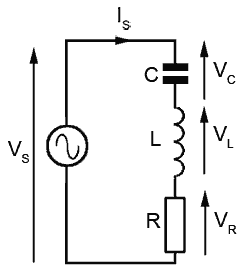
Diagram for Problem 2 of Applications
We continue with further applications on the use of higher
order differential equations to solve problems.
Solution: Note that: 5 cm = 0.05 m,
To get k, the spring constant, note: F = ma = -kx
A 1 kg mass exerts a downward force F = 10 N on the spring (assuming g = 10 ms-2). Since:
F = ma = mg = (1 kg) (10 ms-2) = 10 kgms-2 =
10 N
So: k = 10N/ 0.05m =
200 N/m
i.e. if 10N stretches the spring 0.05m then 200N stretches
it 1 m
The equation of motion is then: mx” +
kx = mg
Or, since m = 1 kg and mg = 10 N: x” +
200 x = 10
Then the general solution is:
x = c1 sin (10)t + c2 cos (10) t + 0.05
At t = 0, x = 10 cm (5cm + 5cm) = 0.1m and:
0.10= 0 + c2 cos (0) + 0.05 = c2 + 0.05
Or: c2 = 0.10 – 0.05 = 0.05
Further: x’ = 0 at t = 0 so that (remember your 1st derivatives of sine, cos!)
The period T = 2 p/w = 2 p/ (10)
= p/
5 s
The frequency f = 1/T = 1/ (p/ 5) = 5/ p
Example (2): Consider the L-C-R series circuit shown.
Here C is a capacitor (which can store charge Q), R is a
resistor, and L is an inductance. The effect of inductance is to oppose any
change in current and contributes to a voltage drop L (dI/dt). The capacitor
meanwhile exhibits a voltage drop of V = C/Q.
By Kirchoff’s law (the total p.d. is the sum of the drops around the loop) it must be true that:
L dI/dt + RI +
Q/C - E = 0
Where E is the electromotive force. But note that the current I is the rate of change of charge Q, so that: I = dQ/dt
Then: dI/dt = d2Q/dt2
So we need to rewrite the differential equation as:
L (d2Q/dt2 ) + R (dQ/dt) + Q/C = E
We know how to form auxiliary equations so we write this
one:
LCm2 + (RC) m + 1 = 0
Let a = (LC), b = (RC) and c = 1 then use the quadratic formula:
{-b + Ö (b2 – 4ac)}/ 2a
To obtain:
m = {- RC + Ö (R2
C2 – 4LC)}/ 2LC
The form of the complementary function will then depend on the form of the discriminant, (R2 C2 – 4LC). The particular integral depends on E, i.e. if E = const. than Q = CE is a particular solution.
Problems for the Math Maven:
1) A 5 lb. weight hangs vertically on a spring
whose spring constant k = 10. The weight is pulled 6 inches farther down
and released. Find the equation of motion, its period and the frequency. What
would the units be for k?
2) For
the circuit shown, consider the special case of NO capacitor. Then the
differential equation of interest becomes:
L (dI/dt) + RI = E
Find the solution if we let E = Eo sin wt.
(Hint: take the integrating factor as: exp (ò adt) =
exp (at)
with a
= R/L )
No comments:
Post a Comment